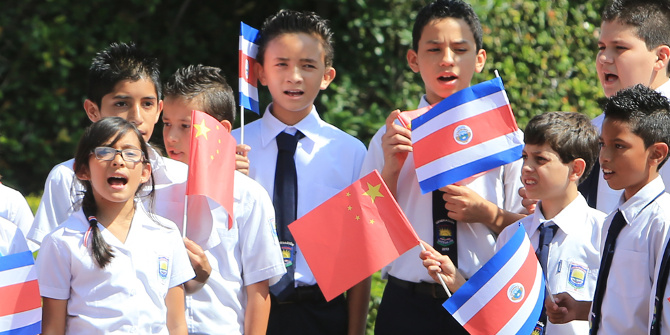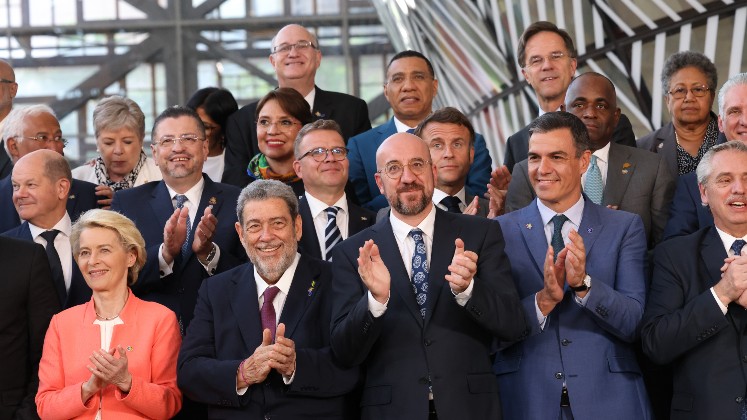 Increased trade, aid, investment, and diplomatic engagement between China and both Costa Rica and Panama signal a more general projection of Chinese economic and political standards in international trade policy, writes Sophie Wintgens (Université Libre de Bruxelles).
Increased trade, aid, investment, and diplomatic engagement between China and both Costa Rica and Panama signal a more general projection of Chinese economic and political standards in international trade policy, writes Sophie Wintgens (Université Libre de Bruxelles).
China’s strategy towards Latin America and the Caribbean (LAC) fulfils four main interests:
- securing energy, mining, and agricultural resources abroad to maintain domestic economic growth
- getting political and economic support in regional and international forums
- encouraging nations to recognise China instead of Taiwan
- opening new markets for Chinese goods
Over the past 15 years, China has become an obvious trading partner, a major source of foreign direct investment, and a key provider of financing to an increasing number of South American countries.
This trend is now extending into Central America, where China’s growing diplomatic involvement and economic activity reveal a strengthening of ties to Beijing.

The geographic characteristics of this narrow isthmus separating the Pacific and Atlantic oceans have already sparked interest from Chinese firms in constructing alternate transit routes to the Panama Canal, as with Nicaragua’s $40 billion interoceanic canal project. Despite its involvement in significant infrastructure projects, Beijing’s relationship with Central America differs from its presence in South America. Central America’s lack of energy and mineral resources, its deeply rooted political and economic connections to the United States, and the 11 states in the hemisphere that still recognise Taiwan have also led Chinese diplomats and firms to focus more on expanded trade and political recognition.
China’s growing economic presence in Central America is especially evident in its exports and development assistance to the region. The relative poverty and lack of infrastructure of the Central American isthmus make recognition of China a profitable move for regional leaders seeking financial aid. Historically, governments switching diplomatic relations to China have been rewarded with investment, improved access to the Chinese market, and loans.
For example, China offered Costa Rica a $130 million aid package and purchased $300 million in Costa Rican bonds. In Panama, meanwhile, aside from being the second most important user of the Panama Canal, China is also the largest supplier of goods to the free-trade zone of Colón. By providing both of these Central American states with public works and economic incentives, Beijing obtained political recognition from Costa Rica in May 2007 and from Panama in June 2017.

For the time being the presence of the Chinese government and corporations remains relatively small in this area. In the long term, however, the increase in economic and trade exchanges with Costa Rica, the first Central American country to establish diplomatic relations and to sign a Free Trade Agreement with Beijing, tallies with the projection of Chinese economic and political standards of international trade policy. The more recent establishment of diplomatic relations with Panama represents another step towards projection of the Beijing Consensus projection into Central America.
Relations between China and South America have already shown evidence of what has been called the “Beijing Consensus”, which reflects China’s own model of development and its basis in three main characteristics: innovation, pursuit of dynamic goals, and self-determination.
When considering its interests, China needs primary products and new markets for its goods, while South American countries need financial aid and loans to develop their infrastructure and provide social programmes. During the first decade of the 2000s, the US’ declining influence in this region and the rise of political movements denouncing the neo-imperialism of the US-backed “Washington Consensus” – promoting fiscal discipline, tax reform, restructured public/social expenditure, competitive exchange rates, liberalised interest rates, liberalised trade, liberalised FDI, privatisation, deregulation, and property rights – contributed to the expansion of China’s normative influence in South America.
Within the context of Trump’s protectionist trade agenda, China could use steadily increasing trade and investment to obtain access to Central America’s emerging markets, gain political partners, and increase its normative influence. By favouring a strategy of free trade without restrictions such as labour and environmental rights, as well as a more activist industrial policy and more generous social transfers, China’s growing economic presence could encourage Central American policy makers to consider efficient alternatives to their low value-added, export-driven development models.
Faced with the persistent supremacy of liberal standards, Central American leaders have an opportunity to promote new development strategies in their own countries.
Notes:
• The views expressed here are of the authors and do not reflect the position of the Centre or of the LSE
• Please read our Comments Policy before commenting
 Sophie Wintgens – Université Libre de Bruxelles
Sophie Wintgens – Université Libre de Bruxelles
Dr Sophie Wintgens is a F.R.S.-FNRS Postdoctoral Researcher at the Centre d’études de la vie politique (Cevipol) of the Université libre de Bruxelles (ULB), Belgium. Her main research interests are emerging powers, multipolarism, global governance issues, and China’s foreign policy towards Europe, Africa and Latin America. She currently works on a research project on China’s normative influence in Central America.





